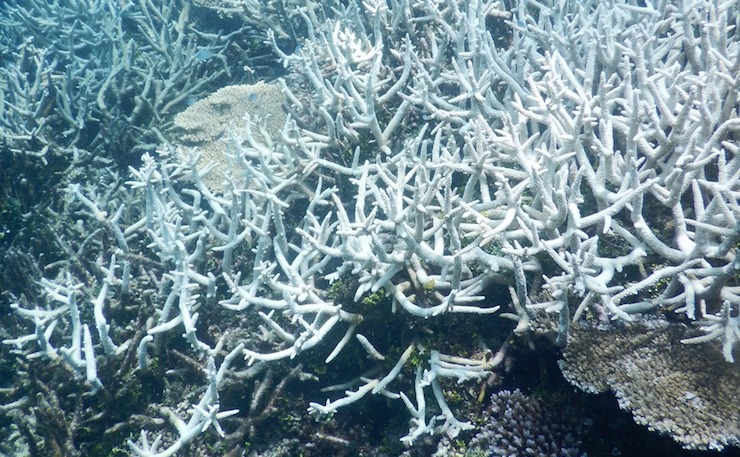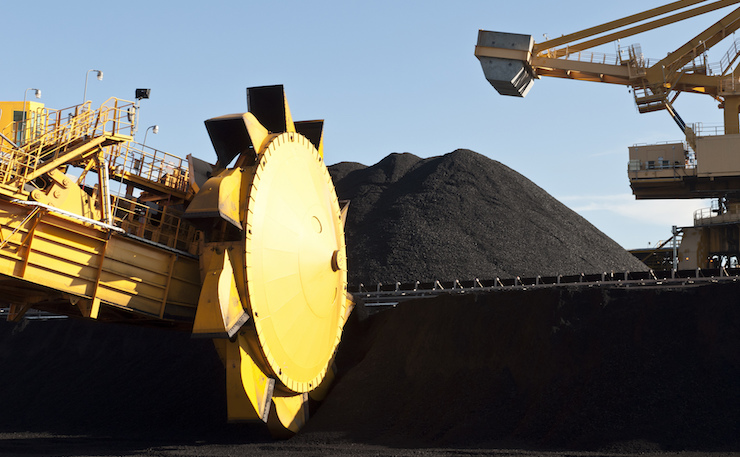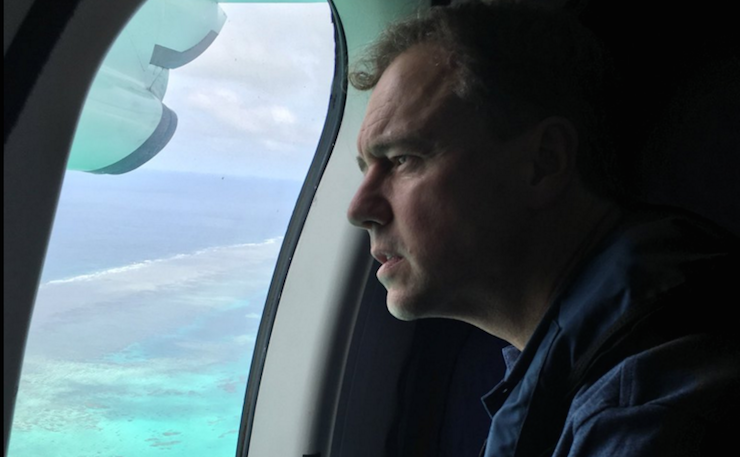Environmental campaigners are making the link between ‘red alert’ coral bleaching on the Great Barrier Reef and plans for a massive new coal province which will fuel similar destruction into the future.
The Great Barrier Reef Marine Park Authority moved to a level three bleaching alert yesterday, which is the highest possible. Bleaching is particularly severe on the far north of the Reef, on inshore Cape York reefs, but has also struck at the southern three quarters of the Reef to the south of Cooktown over recent weeks.
Federal Environment Minister Greg Hunt flew over the Great Barrier Reef on the weekend, and promised resources would be made available to survey 40 sites in the far northern section of the Reef’s 344,400 square kilometre Marine Park.
However the Minister has come under renewed fire for approving Adani’s massive Carmichael Coal Mine, which would be Australia’s largest ever, and would be developed inland of the Great Barrier Reef itself. The mine is one of nine large mines proposed for Queensland’s Galilee Basin, an upscaling of the state’s coal industry which Hunt has shown unrelenting support for.
The coral bleaching underway in Queensland is a clear symptom of the impacts more coal mining will bring. Leading reef scientist Professor Terry Hughes said that “before climate change kicked in, we simply never saw bleaching”.
This season’s bout is being driven by the El Nino weather event, and exacerbated by climate change, and up to half of the corals on some northern reefs are reported by divers to have been killed off.

There has also been damage in the southern three quarters of the reef, but the threat of further bleaching to those sections has largely passed after recent weeks brought wet weather and cloud cover which lowered ocean temperatures in the south.
“We now need to see if local weather conditions over the next few weeks are favourable enough to prevent further bleaching and to help these [southern]reefs recover from the minor to moderate bleaching that we’re continuing to see south of Cooktown,” said Great Barrier Reef Marine Park Authority Chairman Dr Russell Reichelt.
“We still have many more reefs to survey to gauge the full impact of bleaching, however unfortunately, the further north we go from Cooktown, the more coral mortality we’re finding.
“The corals in the remote far north of the Reef experienced extremely hot and still conditions this summer, and were effectively bathed in warm water for months, creating heat stress that they could no longer cope with.
“The reefs that we’ve surveyed so far indicate the large low pressure system over the north last week simply arrived too late for some.”
The coral bleaching is not yet as bad as events in 1998 and 2002, when up to 50 per cent of the Great Barrier Reef was affected, but it is inevitable in a climate-changed world that there will be more.
Joined GBRMPA monitoring flight over #GreatBarrierReef today. Announced support for more coral bleaching research pic.twitter.com/gOoAd0vxjP
— Greg Hunt (@GregHuntMP) March 20, 2016
Coral bleaching has swept the reefs of the world since mid-2014, beginning in the north Pacific and expanding into the south Pacific and Indian Oceans in 2015. The current El Nino weather system is driving up global temperatures, already rising from a base-line lifted by climate change, and has seen multiple records broken for ocean temperatures over recent months.
According to a statement released by the Climate Council at the weekend, temperatures in the water off far-northern Queensland reached as high as 33 degrees last month, which was the hottest February on record globally.
Advocates are calling for an end to the massive expansion of coal mining in Queensland.
“If we continue to burn fossil fuels and warm the climate, we are likely to lose most corals worldwide in as little as 30 to 40 years. To prevent this tragedy, most of the world’s fossil fuel reserves must stay in the ground,” the Climate Council’s Professor Tim Flannery said.
“That’s why we need policies that will create an orderly closure of our ageing and polluting coal-fired power stations to make way for modern, clean and efficient renewables.”
Government scientists recognise climate change as the greatest long-term threat the Great Barrier Reef, but that didn’t stop Minister Hunt approving what would be Australia’s largest coal mine, Adani’s Carmichael Mine.

Greenpeace is urging Hunt’s state counterpart Anthony Lynham, Queensland’s Minister for Natural Resources and Mines, to see this year’s bleaching as “a line in the sand” and put an end to plans for gargantuan new coal fields.
Analysis by Greenpeace has shown that if all of the mines proposed for the Galilee Basin go ahead, they would produce emissions on par with those of nations such as the United Kingdom, Australia and South Africa. The coal would also be shipped through the Great Barrier Reef for export.
“Regardless of where it’s sold and sent, Australia coal will contribute to greenhouse gas pollution, and that will still fuel climate change,” said Shani Tager, Greenpeace Australia Pacific Reef Campaigner.
“The Reef is of the world’s greatest natural wonders, it’s beloved by Australians and people around the world, and is home for thousands of species. This is the highest warning possible for the Reef and it must be the line in the sand,” she said.
“Our Government’s addiction to the coal industry must be broken.”
Donate To New Matilda
New Matilda is a small, independent media outlet. We survive through reader contributions, and never losing a lawsuit. If you got something from this article, giving something back helps us to continue speaking truth to power. Every little bit counts.





